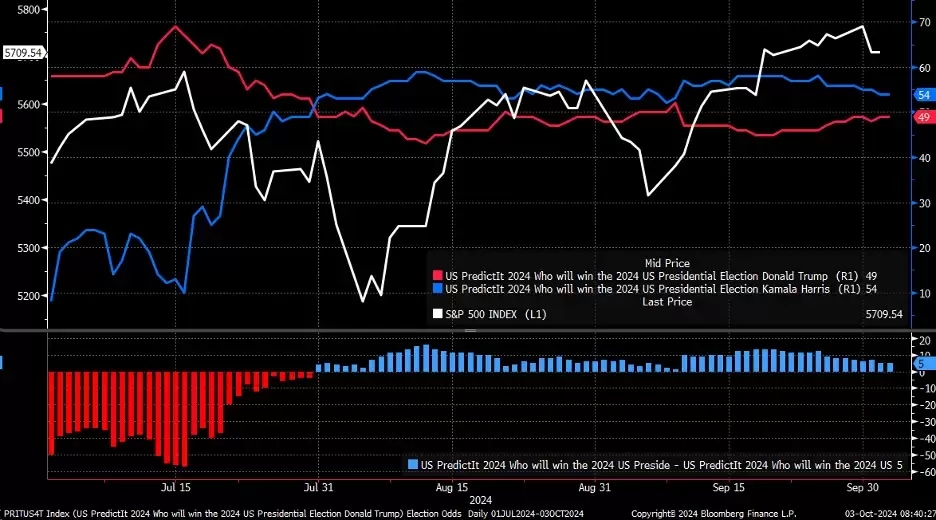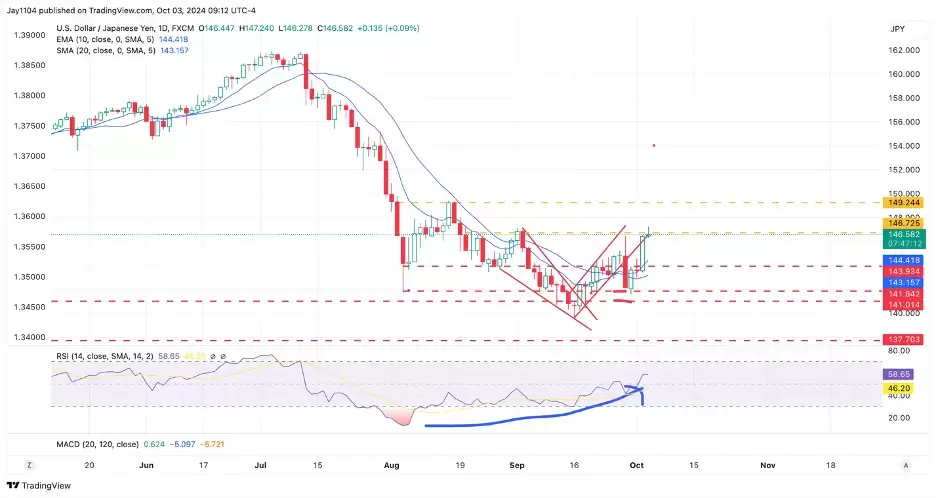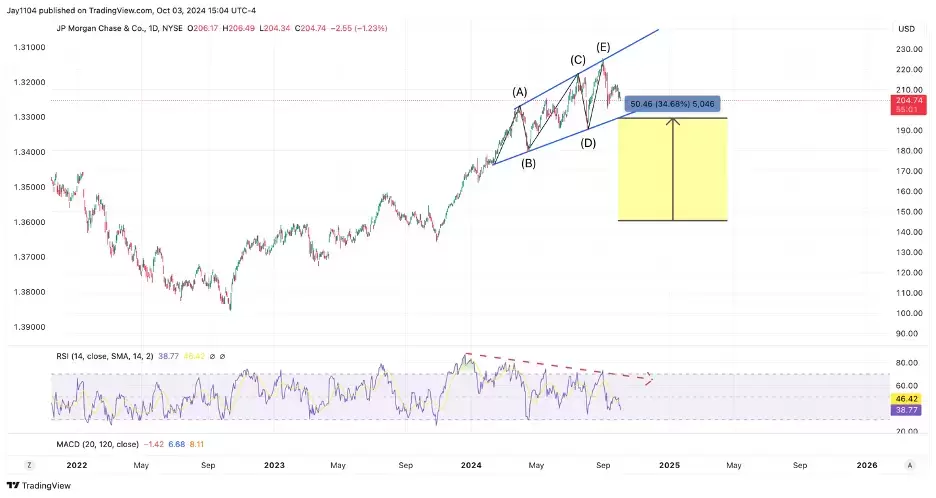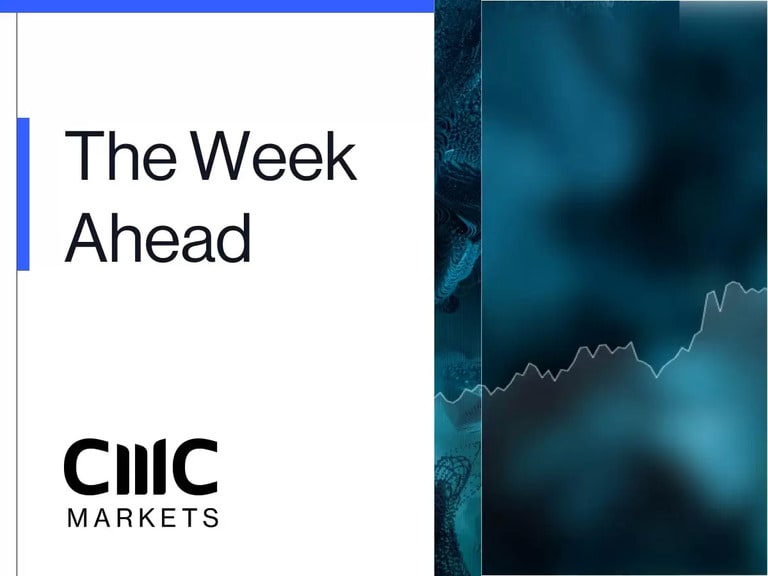
Welcome to Michael Kramer’s pick of the market events to watch in the coming week. With the US presidential election now just a month away, Michael starts his preview with a look at what the betting market is saying about the two leading candidates’ chances. He then focuses on the key upcoming stories – the Fed’s meeting minutes, US inflation data for September, and the start of a fresh earnings season led by major US banks, chief among them JPMorgan – and analyses the financial instruments that could be impacted.
US election update
The betting market has tightened in the past week. The likelihood of a victory for Democratic candidate Kamala Harris in November’s US presidential election has dropped to 54%, while the odds of a win for her Republican rival Donald Trump have risen to 49%, according to PredictIt, an online betting site that covers political events. This closes the gap to a spread of just five percentage points, as the lower part of the below chart illustrates. Harris has held a narrow lead over Trump since the end of July.
PredictIt’s data shows that, among those betting on Harris, 54% now back her to win while 46% bet she’ll lose. Meanwhile 49% of Trump bettors are backing him to win while 51% bet he’ll lose.
Despite the tightness of the race for the White House, we have not yet seen the kind of market jitters that typically precede a US presidential election Indeed, the S&P 500 hit record highs in September. Wall Street’s benchmark index is up 3.3% in the past month at 5,700 points, as of Friday morning.
PredictIt’s US 2024 election poll tracker has Harris on a five-point lead

Historically, in the lead-up to a US presidential election, we see the VIXvolatility index – commonly known as Wall Street’s “fear gauge” – rise on an almost daily basis. In election years from 1992 to 2020, the VIX has, on average, peaked at around 22 (an outlier was 2008, when volatility spiked due to the financial crisis). A reading below 20 usually corresponds to stable levels of market activity, while a reading of 30 or above indicates that extreme levels of market volatility are expected over the next 30 days.
This year, the VIX has been as high as 41 and as low as 16. Based on historical patterns, implied volatility may continue to rise as the 5 November election approaches, potentially putting downward pressure on equity prices.
VIX volatility index in US election years, 1992-2020 vs 2024

US Federal Reserve minutes
Wednesday 9 October
The minutes from the Federal Reserve’s 17-18 September meeting, due to be released on Wednesday, could offer traders and investors insights into how far and how fast the Fed plans to cut interest rates. The threat of large, sudden rate cuts poses a significant downside risk for US equity markets, given that price-to-earnings ratios of US stocks have reached extreme highs compared to historical P/E ratios during periods of expected rate cuts. The semiconductor sector – particularly the VanEck Semiconductor ETF [SMH], up 45% year-to-date at about $245 – may be particularly vulnerable in the event of a market downturn.
SMH’s relative strength index (RSI), a momentum indicator, has entered a period of consolidation, while the price chart shows a potential bear pennant. If SMH breaks below the uptrend and slips towards the $226 to $227 range, it could plunge to the August lows near $198. Otherwise, upside resistance is at $257.
VanEck semiconductor ETF, January 2024 - present

US September CPI
Thursday 10 October
For US policymakers, inflation seems to have taken a back seat to labour market concerns in recent months, but that doesn’t mean inflation has been forgotten. Analysts estimate that US consumer prices grew 2.3% in the year September, easing from 2.5% in August. They also expect the monthly inflation rate to come in at 0.1%, down from 0.2% in August. Meanwhile, core CPI – which excludes volatile items such as food and energy – is expected to be stickier, remaining unchanged at 3.2% in September, with the monthly figure up 0.2%, down from 0.3% in August.
CPI swaps are pricing in a possible upside surprise in the September data. They predict the headline rate of consumer price inflation could come in at 2.36% year-on-year and 0.15% month-on-month. Both figures are rounded up to one decimal place, potentially bringing them to 2.4% and 0.2%, respectively. That would signal hotter-than-expected inflation, which could trigger volatility for the US dollar. That’s because a higher-than-expected inflation print might deter policymakers from cutting interest rates, potentially strengthening the dollar, particularly against the Japanese yen, which has seen considerable volatility recently.
The RSI for USD/JPY has been trending higher, indicating that momentum has taken an upwards turn. A breakout above ¥147 could send the pair towards ¥149.25 in the near term.
USD/JPY, May 2024 - present

JPMorgan Q3 results
Friday 11 October
Analysts are forecasting that JPMorgan Chase’s third-quarter earnings fell 7.3% year-on-year to $4.01 a share, despite revenue growing an estimated 3.1% to $41.9bn. Trading revenue is expected to be up 6% at $6.97bn, with net interest income falling by less than 1% to $22.7bn.
For the fourth quarter, analysts expect the US’s largest bank by assets to guide a 6% year-on-year drop in per-share earnings to $3.73, and a 3% uptick in revenue to $41.1bn, with net interest income set to fall 6.8% to $22.4bn.
Options market pricing suggests that the bank’s share price – which ended Thursday at $205.23, up 19.2% year-to-date – could move higher or lower within a range of about 3% following the Q3 results announcement.
The stock appears to have formed a bearish ascending megaphone pattern, as highlighted on the chart below. The shares have touched the upper trendline three times this year and are now falling towards the lower trendline, around $200. If the stock breaks below that lower trendline, it could sink to lower levels over time. On the other hand, if the share price stays within the bounds of the two trendlines, it could rise towards the upper trendline near $230.
JPMorgan Chase share price, 2022 - present

Key economic and company events
Our rundown of notable economic announcements and US and UK company reports scheduled for the coming week:
Monday 7 October
• Eurozone: August retail sales
• Germany: August factory orders
• Results: Duckhorn Portfolio (Q4)
Tuesday 8 October
• Australia: Reserve Bank of Australia meeting minutes, October Westpac consumer confidence report
• Eurozone: Eurogroup meeting
• Germany: August industrial production
• Results: PepsiCo (Q3)
Wednesday 9 October
• Germany: August exports, imports and trade balance
• New Zealand: Reserve Bank of New Zealand interest rate decision
• US: Federal reserve meeting minutes
• Results: Applied Digital Corporation (Q1)
Thursday 10 October
• Australia: October consumer inflation expectations
• UK: Bank of England monetary policy report hearings
• US: September consumer price index (CPI), initial jobless claims to 4 October
• Results: AZZ (Q2), Delta Air Lines (Q3), Domino’s Pizza (Q3)
Friday 11 October
• Canada: September employment data
• Germany: September harmonised CPI
• UK: August gross domestic product (GDP)
• US: September producer price index (PPI), October flash Michigan consumer sentiment index
• Results: Bank Of New York Mellon (Q3), BlackRock (Q3), Fastenal (Q3), Hays (Q1), JPMorgan Chase (Q3), Jupiter Fund Management (Q3), Wells Fargo (Q3)
Note: While we check all dates carefully to ensure that they are correct at the time of writing, the above announcements are subject to change.
Disclaimer: CMC Markets is an execution-only service provider. The material (whether or not it states any opinions) is for general information purposes only, and does not take into account your personal circumstances or objectives. Nothing in this material is (or should be considered to be) financial, investment or other advice on which reliance should be placed. No opinion given in the material constitutes a recommendation by CMC Markets or the author that any particular investment, security, transaction or investment strategy is suitable for any specific person. The material has not been prepared in accordance with legal requirements designed to promote the independence of investment research. Although we are not specifically prevented from dealing before providing this material, we do not seek to take advantage of the material prior to its dissemination.





















